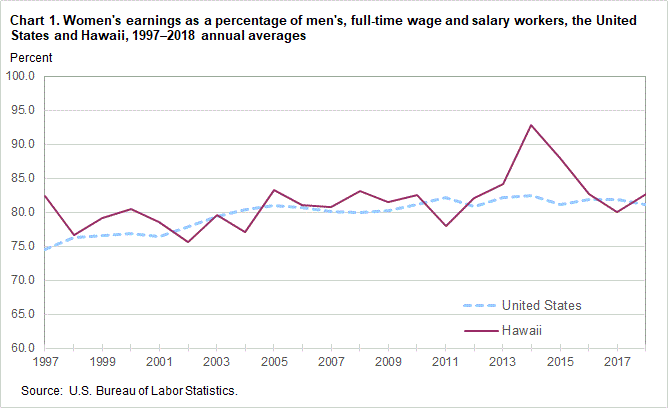Women’s Earnings in Hawaii – 2018
News Release from Bureau of Labor Statistics, January 8, 2020
In 2018, Hawaii women who were full-time wage and salary workers had median usual weekly earnings of $797, or 82.6 percent of the $965 median usual weekly earnings of their male counterparts, the U.S. Bureau of Labor Statistics reported today. Assistant Commissioner for Regional Operations Richard Holden noted that the 2018 women’s-to-men’s earnings ratio in Hawaii increased from 2017, up 2.6 percentage points. Nationwide, women earned $789 per week or 81.1 percent of the $973 median for men. (See table 1. The earnings comparisons in this release are on a broad level and do not control for many factors that can be significant in explaining earnings differences, such as job skills and responsibilities, work experience, and specialization.)
In Hawaii, the women’s-to-men’s earnings ratio has ranged from a low of 75.7 percent in 2002 to a high of 92.8 percent in 2014. In 2018, the ratio increased after decreasing in each of the previous three years. (See chart 1. Data for the states began in 1997.)

Among the 50 states, median weekly earnings of women in full-time wage and salary positions in 2018 ranged from $637 in Mississippi to $995 in Massachusetts. In addition to Massachusetts, women’s earnings in Colorado, Connecticut, Maryland, Minnesota, and New Jersey were above $900 per week. In the District of Columbia, women earned a median weekly wage of $1,259. (See table 1 and chart 2.)
Median weekly earnings for men were lowest in Arkansas at $809 and highest in Massachusetts at $1,170. Five other states (Connecticut, Maryland, New Hampshire, New Jersey, and Hawaii) had weekly wages above $1,100 for full-time male workers. In the District of Columbia, men earned a median weekly wage of $1,445.
California had the highest women’s-to-men’s earnings ratio among the states, 88.3 percent, and Wyoming had the lowest, 67.8 percent. The District of Columbia had a ratio of 87.1 percent. (See chart 3.) The differences among the states reflect, in part, variation in the occupations and industries found in each state and differences in the demographic composition of each state’s labor force. In addition, sampling error for state estimates is considerably larger than it is for the national estimates. Consequently, earnings comparisons between states should be made with caution.
read … News Release
PBN: Bureau of Labor Statistics: Hawaii among best states for wage equity between men, women
HPR: Caregiving Could Help Explain Why Hawaii's Women Earn Less Than Men